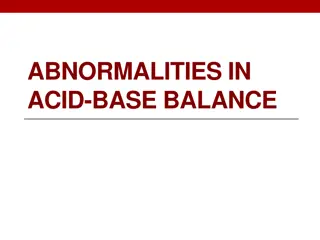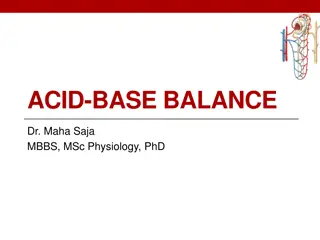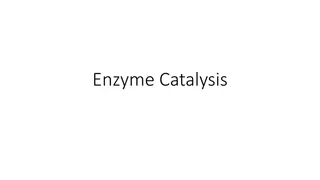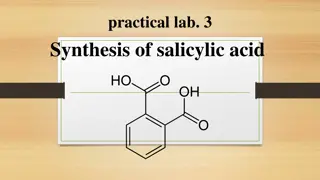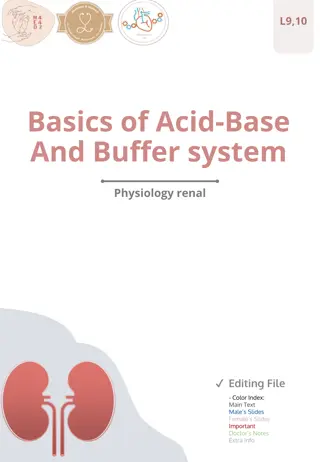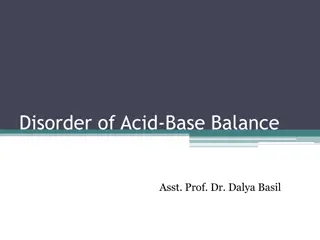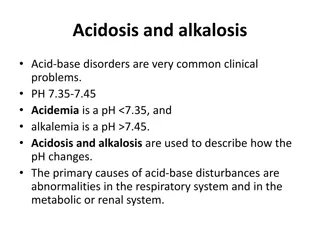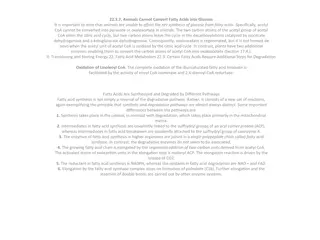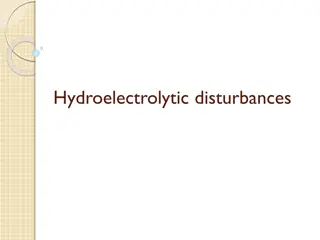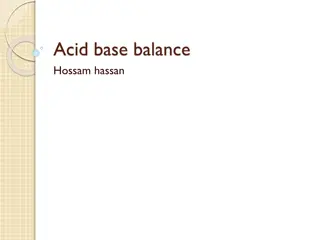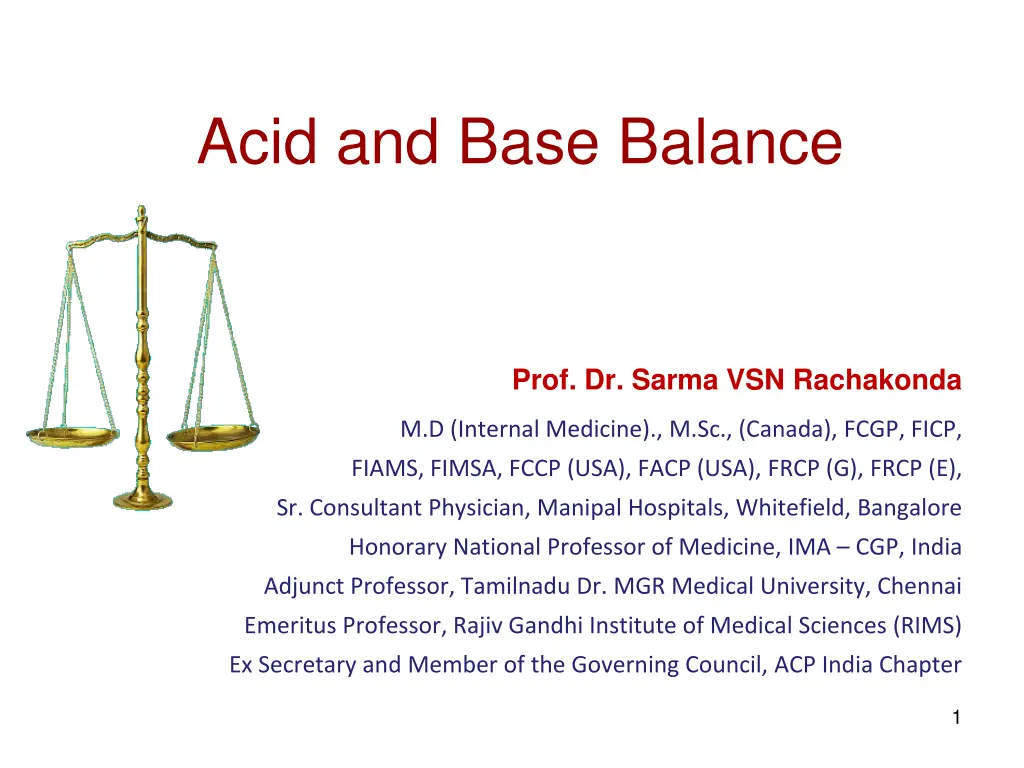
Acid and Base Balance: Understanding Disorders, Basics, and Assessment
Explore the intricate balance of acid and base levels in the body with detailed explanations of acidosis, alkalosis, compensation mechanisms, and assessment methods. Learn from Prof. Dr. Sarma VSN Rachakonda's expertise in maintaining pH homeostasis for optimal health.
Download Presentation

Please find below an Image/Link to download the presentation.
The content on the website is provided AS IS for your information and personal use only. It may not be sold, licensed, or shared on other websites without obtaining consent from the author. If you encounter any issues during the download, it is possible that the publisher has removed the file from their server.
You are allowed to download the files provided on this website for personal or commercial use, subject to the condition that they are used lawfully. All files are the property of their respective owners.
The content on the website is provided AS IS for your information and personal use only. It may not be sold, licensed, or shared on other websites without obtaining consent from the author.
E N D
Presentation Transcript
Acid and Base Balance Prof. Dr. Sarma VSN Rachakonda M.D (Internal Medicine)., M.Sc., (Canada), FCGP, FICP, FIAMS, FIMSA, FCCP (USA), FACP (USA), FRCP (G), FRCP (E), Sr. Consultant Physician, Manipal Hospitals, Whitefield, Bangalore Honorary National Professor of Medicine, IMA CGP, India Adjunct Professor, Tamilnadu Dr. MGR Medical University, Chennai Emeritus Professor, Rajiv Gandhi Institute of Medical Sciences (RIMS) Ex Secretary and Member of the Governing Council, ACP India Chapter 1
Disorders of A-B balance Acidosis: abnormal condition lowering arterial pH before secondary changes in response to the primary aetiological factor Alkalosis: abnormal condition raising arterial pH before secondary changes in response to the primary aetiological factor Simple A-B disorders: there is a single primary aetiological acid-base disorder Mixed A-B disorders: more primary aetiological disorders are present simultaneously Acidaemia: arterial pH<7.36 (i.e. [H+]>44 nM) Alkalaemia: arterial pH>7.44 (i.e. [H+]<36 nM)
Basics Acidosis / Alkalosis : refer to processes which cause acid / alkali to accumulate. They do not imply any abnormality in the pH. Buffer: substance which can absorb / donate ions and mitigate but not prevent changes in pH. Compensation is a not a perfect process. If we were to correct an acid/base disturbance it would be removing the stimulus to do so.
Assessment of A-B balance Arterial blood Mixed venous blood range range pH 7.40 7.35-7.45 pH 7.33-7.43 pCO2 40 mmHg 35 45 pCO2 41 51 pO2 95 mmHg 80 95 pO2 35 49 Saturation 95 % 80 95 Saturation 70 75 BE 2 BE HCO3- 24 mEq/l 22 - 26 HCO3- 24 - 28
The Body and pH Homeostasis of pH is tightly controlled Extracellular fluid = 7.4 Blood = 7.35 7.45 < 7.35: Acidosis (acidemia) > 7.45: Alkalosis (alkalemia) < 6.8 or > 8.0: death occurs 5
The body produces more acids than bases Acids take in with foods. Cellular metabolism produces CO2. Acids produced by metabolism of lipids and proteins. CO2 H2CO3 CO2+ H2O Volatile acid CO2 CO2 (H+ 15 20 mol /d) H2SO4 H3PO4 Uric acid Lactic acid Ketone body (H+ < 0.05 0.10 mol /d) Fixed acid 7
Maintenance of blood pH Three lines of defense to regulate the body s acid-base balance Blood buffers (Instantaneous) Respiratory mechanism (Few Hours) Renal mechanism ( Days to a week) 8
Buffer systems Take up H+ or release H+ as conditions change Buffer pairs weak acid and a base Exchange a strong acid or base for a weak one Results in a much smaller pH change 9
Bicarbonate buffer HCl + NaHCO3 H2CO3 + NaCl NaOH + H2CO3 NaHCO3 + H2O 10
Phosphate buffer Major intracellular buffer NaH2PO4-Na2HPO4 H+ + HPO42- H2PO4- OH- + H2PO4- H2O + HPO42- 11
Protein Buffers Include plasma proteins and hemoglobin Carboxyl group gives up H+ Amino Group accepts H+ 12
Principal buffers in blood in Plasma in RBC H2CO3 / HCO3- 35% 18% HHb / Hb- 35% HPro / Pro- 7% H2PO4- / HPO42- Total 5% 58% 42% 13
Respiratory mechanisms CO2 CO2 Exhalation of CO2 Rapid, powerful, but only works with volatile acids H+ + HCO3- H2CO3 Doesn t affect fixed acids like lactic acid Body pH can be adjusted by changing rate and depth of breathing CO2 + H20 14
2. Renal Mechanism of H+ regulation pH = pKa + log {[HCO3-]/0.03 PCO2} While the lungs take care of the CO2 aspect of the equation, the kidneys adjust and regulate pH by regulating the bicarbonate levels in the body. Kidneys role in acid base is Excrete H+ ions Reabsorb HCO3- ions Make new HCO3- ions 15
Kidney Excretion Most effective regulator of pH The pH of urine is normally acidic (~6.0) H+ ions generated in the body are eliminated by acidified urine. Can eliminate large amounts of acid ( H+) Reabsorption of bicarbonate (HCO3-) ( HCO3-) Excretion of ammonium ions(NH4+) ( NH4+) If kidneys fail, pH balance fails 16
To find the reason for the disturbances , we need to remember who controls what and thus look at the factors responsible for a particular acid-base status. pH = pKa + log {[HCO3-]/0.03 PCO2} [HCO3-] (controlled by kidneys) pH ~ PCO2 (controlled by lungs) We thus need to look at the ratio of bicarbonate to CO2 (which should be 20 to 1 in order to have a pH of 7.4) 17
Rates of correction Buffers function: almost instantaneously Respiratory mechanisms: take several minutes to hours Renal mechanisms: may take several hours to days 18
Acid-Base Imbalances Acidosis- a decline in blood pH Metabolic acidosis: due to a decrease in bicarbonate. Respiratory acidosis: due to an increase in carbonic acid. Alkalosis- a rise in blood pH Metabolic alkalosis: due to an increase in bicarbonate. Respiratory alkalosis : due to a decrease in carbonic acid. 21
Compensation If underlying problem is metabolic, hyperventilation or hypoventilation can help: respiratory compensation. If problem is respiratory, renal mechanisms can bring about metabolic compensation. 23
Law of Mass Action H+ + HCO3- CA CO2 + H2O H2CO3 AT EQUILIBRIUM, [H+] x [HCO3-] K = [H2CO3] [H+] x [HCO3-] = SOLUBILITY x PCO2
[H+] x [HCO3-] K = 0.03 x PCO2 WHICH, AFTER TAKING LOGS, BECOMES: [HCO3-] pH = pK + Log( ) 0.03 x PCO2 - THE HENDERSON - HASSELBALCH EQUATION
Convert [H+] to pH: Subtract calculated [H+] from 80; this gives the last two digits of a pH beginning with 7 example: calculated [H+] of 24 converts to pH of (80-24)~7.56 example: calculated [H+] of 53 converts to pH of (80-53)~7.27 Refer to table 1 in handout for more precise conversion, or if calculated [H+] exceeds 80
Relationship between [H+] & pH [H+] [H+] pH pH 7.80 7.75 7.70 7.65 7.60 7.55 7.50 7.45 7.40 7.35 16 18 20 22 25 28 32 35 40 45 7.30 7.25 7.20 7.15 7.10 7.00 6.95 6.90 6.85 6.80 50 56 63 71 79 89 100 112 141 159
Potassium Potassium : weather vein : The serum K can be used as a poor man s pH meter in the absence of pH measure. This can help to differentiate between acidosis vs. compensated alkalosis for example in the setting of a low HCO3. This effect is stronger for inorganic acidoses.
The Anion Gap Na (Cl + HCO3) NaHCO3 + HCL NaCL + H2CO3 NaHCO3 + HX NaX+ H2CO3 Unmeasured cations: calcium, magnesium, gamma globulins, potassium. Unmeasured anions: albumin, phosphate, sulfate, lactate.
Anion Gap: Based on the concept of electroneutrality; the assumption that the sum of all available cations= the sum of all available anions. Restated as: Na+ + Unmeasured Cations (UC) = Cl- + HCO3 + Unmeasure Anions (UA); conventionally restated: Na+-(Cl-+HCO3)=UA-UC=Anion Gap=12 to 14
Anion Gap: Na+-(Cl-+HCO3)=UA-UC Serum albumin contributes ~1/2 of the total anion equivalency of the UA pool. Assuming normal electrolytes, a 1gm/dl decline in serum albumin decreases the anion gap factitiously by 3 mEq/L. Therefore an anion gap of 12 mEq/L is corrected to 17-18 mEq/L when the serum albumin is half of normal; this is an important correction factor in settings of chronic illness or malnourished patients
Normal Serum Values Serum Cations Na+ 140 mEq/L Serum Anions Cl- 103 K+ 4 HCO3- 25 Proteins 19 Ca2+ 5 Mg2+ 2 Others 4 Total 151 Total 151 Concentration of Mg, K, and Ca are usually pretty constant. Concentrations of proteins is also constant. Thus subtraction of values of Cl- and HCO3- from Na+ values should yield a value of 12 mEq/L. 34
Values higher than 16 mEq/L indicate the presence of unknown anions, with the difference being the concentration of the unknown anion. Normal Patient 140 Na+ 140 mEq/L Cl- 103 103 HCO3- 25 Anion Gap 12 10 27 Values for HCO3- are lower than normal Metabolic Acidosis AG is significantly higher Unknown anion ~ (27-12) = 15 mEq/L 35
Decreased anion gap Decrease in unmeasured anions Hypoalbuminemia Increase in unmeasured cations Hypercalcemia Hypermagnesemia Hyperkalemia Multiple myeloma Lithium toxicity
Respiratory Acidosis Elevation of CO2 above normal with a drop in extracellular pH. This is a disorder of ventilation. Rate of CO2 elimination is lower than the production 5 main categories: CNS depression Pleural disease Lung diseases such as COPD and ARDS Musculoskeletal disorders Compensatory mechanism for metabolic alkalosis
Respiratory Acidosis Acute or Chronic: has the kidney had enough time to partially compensate? The source of the BUFFER (we need to produce bicarb) is different in these states and thus we need to make this distinction.
Respiratory Acidosis Acute : H is titrated by non HCO3 organic tissue buffers. Hb is an example. The kidney has little involvement in this phase. 10 mm Hg increase in CO2 / pH should decrease by .08 Chronic: The mechanism here is the renal synthesis and retention of bicarbonate. As HCO3 is added to the blood we see that [Cl] will decrease to balance charges. This is the hypochloremia of chronic metabolic acidosis. 10 mm H increase in CO2 / pH should decrease by .03
Respiratory Alkalosis Initiated by a fall in the CO2 activate processes which lower HCO3. Associated with mild hypokalemia. Cl is retained to offset the loss of HCO3 negative charge. Acute response is independent of renal HCO3 wasting. The chronic compensation is governed by renal HCO3 wasting. Causes Intracerebral hemorrhage Drug use : salicylates and progesterone Decreased lung compliance Anxiety Liver cirrhosis Sepsis
Respiratory Alkalosis Acute or Chronic: has the kidney had enough time to partially compensate? Acute : 10 mm Hg decrease in CO2 / pH should increase by .08 Chronic : 10 mm H decrease in CO2 / pH should increase by .03 After two weeks we may have a complete compensation at the level of the kidney. This is demonstrated in people living at high altitudes (hypoxia induced hyperventilation).
Metabolic Acidosis Gap vs. Non-Gap Where does the normal gap of 12 come from? It is the difference between unmeasured cations and anions. Anion gap acidosis: 4 major categories Renal failure Ketoacidosis : diabetes / alcohol withdrawal Drugs or Poisons paraldehyde, ethylene glycol. Lactic acidosis: associated with inadequate tissue perfusion. : methanol, salicylates,
Non Gap Acidosis H: hyperalimentation A: acetazolamide R: RTA D: diarrhea U: rectosigmoidostomy P: pancreatic fistula
A good mnemonic for the common causes of increased anion gap metabolic acidoses is MUDPILES. Methanol Uremia Diabetic ketoacidosis Paraldehyde Infections Lactic acidosis Ethylene Glycol Salicylates 44
8 Sequential Rules: Rule #1 Must know the pH; pH determines whether the primary disorder is an acidosis or an alkalosis Rule #2 Must know the PaCO2 and serum HCO3- Rule #3 Must be able to establish that the available data (pH, PaCO2, and HCO3-) are consistent
Are the data consistent? The Henderson Equation: PaCO + = 2 24 H 3 HCO
Simple Acid-Base Disorders: Type of Disorder Metabolic Acidosis Metabolic Alkalosis Acute Respiratory Acidosis Chronic Respiratory Acidosis Acute Respiratory Alkalosis Chronic Respiratory Alkalosis pH PaCO2 [HCO3]
Simple Acid-Base Disorders: Type of Disorder Metabolic Acidosis Metabolic Alkalosis Acute Respiratory Acidosis Chronic Respiratory Acidosis Acute Respiratory Alkalosis Chronic Respiratory Alkalosis pH PaCO2 [HCO3]
Simple Acid-Base Disorders: Type of Disorder Metabolic Acidosis Metabolic Alkalosis Acute Respiratory Acidosis Chronic Respiratory Acidosis Acute Respiratory Alkalosis Chronic Respiratory Alkalosis pH PaCO2 [HCO3]
Simple Acid-Base Disorders: Type of Disorder Metabolic Acidosis Metabolic Alkalosis Acute Respiratory Acidosis Chronic Respiratory Acidosis Acute Respiratory Alkalosis Chronic Respiratory Alkalosis pH PaCO2 [HCO3]
Simple Acid-Base Disorders: Type of Disorder Metabolic Acidosis Metabolic Alkalosis Acute Respiratory Acidosis Chronic Respiratory Acidosis Acute Respiratory Alkalosis Chronic Respiratory Alkalosis pH PaCO2 [HCO3]


